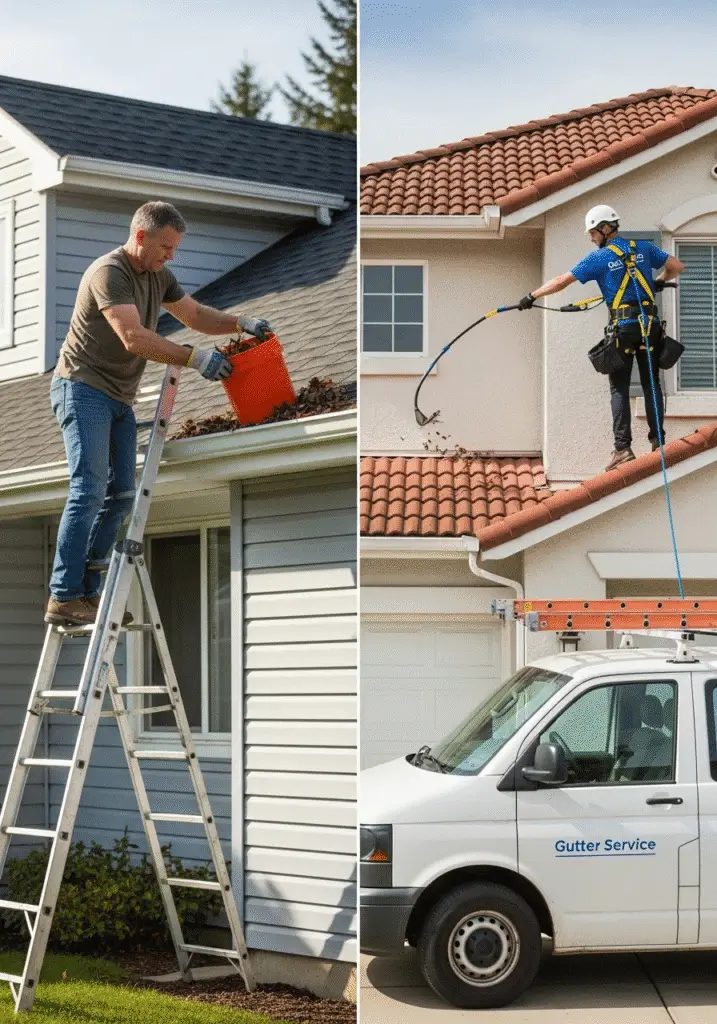Introduction
As the rainy season draws near, preparing your home for heavy rainfall should be a top priority—and one of the most vital yet commonly neglected tasks is gutter cleaning. Gutters play a crucial role in directing rainwater away from your roof, walls, foundation, and landscaping. When they become clogged with leaves, dirt, debris, or even bird nests, water can overflow and seep into your home, causing serious damage such as roof leaks, mold infestations, basement flooding, and structural weakening.
In this comprehensive guide, we’ll explore the importance of cleaning your gutters before the rainy season arrives. You’ll learn how a simple maintenance routine can prevent costly repairs and protect the integrity of your home. We’ll cover everything from the essential tools you need and step-by-step cleaning instructions to expert safety tips and preventative maintenance strategies. Whether you’re a seasoned homeowner or tackling gutter cleaning for the first time, this blog post will equip you with all the knowledge you need to get the job done efficiently and safely.
Proper gutter maintenance doesn’t just save money—it also extends the life of your roof and foundation. By investing a little time and effort now, you can avoid major water-related problems later. So, grab your gloves and ladder, and let’s get your home rain-ready. From spotting early signs of blockage to installing gutter guards for long-term protection, we’ve got you covered in this all-in-one guide to pre-rainy season gutter care.
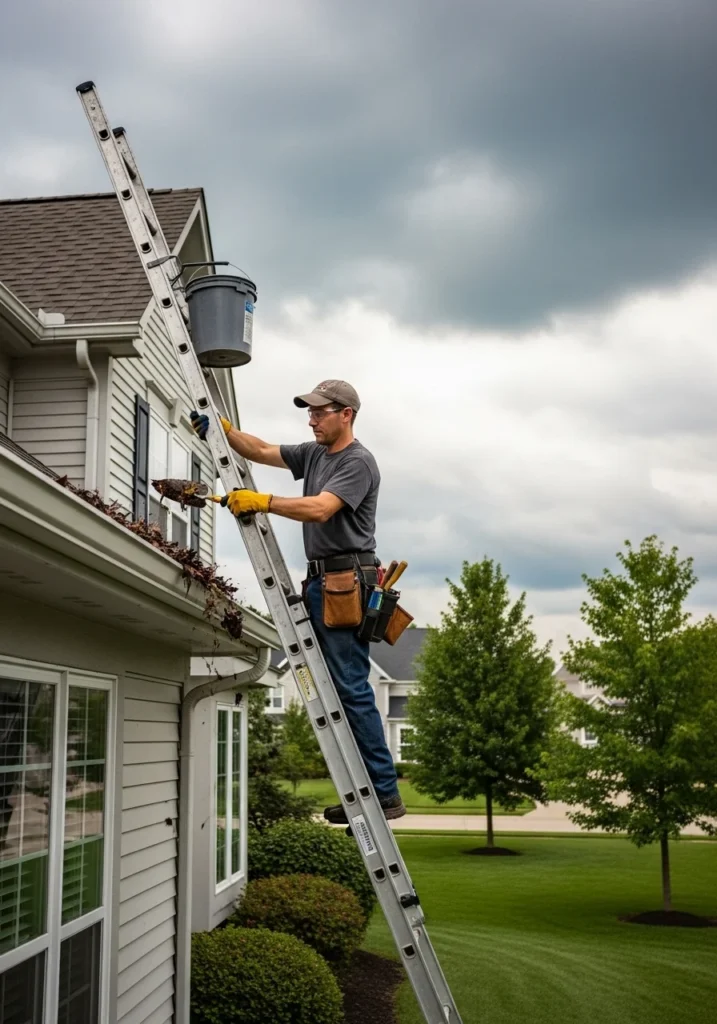
Why Gutter Cleaning Matters Before Rainy Season
Gutters are a fundamental part of your home’s drainage system. Their main purpose is to guide rainwater safely away from your roof, exterior walls, foundation, and landscaping. However, when gutters become clogged with organic debris like leaves, twigs, dirt, moss, and even bird nests, their functionality is severely compromised. Instead of water flowing smoothly through the downspouts, it begins to pool, overflow, and spill over the edges—often leading to significant damage that can be both dangerous and expensive to fix.
Water Damage to the Structure: One of the most common consequences of clogged gutters is water damage. Overflowing water can seep into your roof, siding, or the interior of your walls, causing stains, rot, and deterioration over time. Ceilings may develop unsightly brown spots or even start to sag if leaks go unnoticed for too long.
Foundation Cracks & Basement Flooding: When water is not properly diverted away from your home, it pools around the foundation. Over time, this can lead to cracks in the foundation and, in severe cases, cause basement flooding. Once a basement floods, it becomes susceptible to mold, mildew, and structural instability.
Pest Infestations: Clogged gutters create ideal conditions for pests. Stagnant water attracts mosquitoes, while accumulated organic debris becomes a nesting ground for rodents, birds, and insects. These pests can eventually find their way inside your home, creating an even bigger issue.
Mold and Mildew Growth: Moist environments are breeding grounds for mold and mildew. Once mold starts growing inside walls or under roofing materials, it spreads quickly and poses health risks to your family—especially for those with allergies or respiratory issues.
Preventive Timing is Key: The best time to clean your gutters is in late spring or early summer—right before the rainy season begins. Regular gutter cleaning prevents these issues from developing and ensures your home remains safe, dry, and structurally sound. By being proactive rather than reactive, you save thousands in potential repair costs and maintain the long-term value of your property.
In short, cleaning your gutters before the rains arrive isn’t just a chore—it’s a critical step in protecting your home and family from avoidable water-related damage.
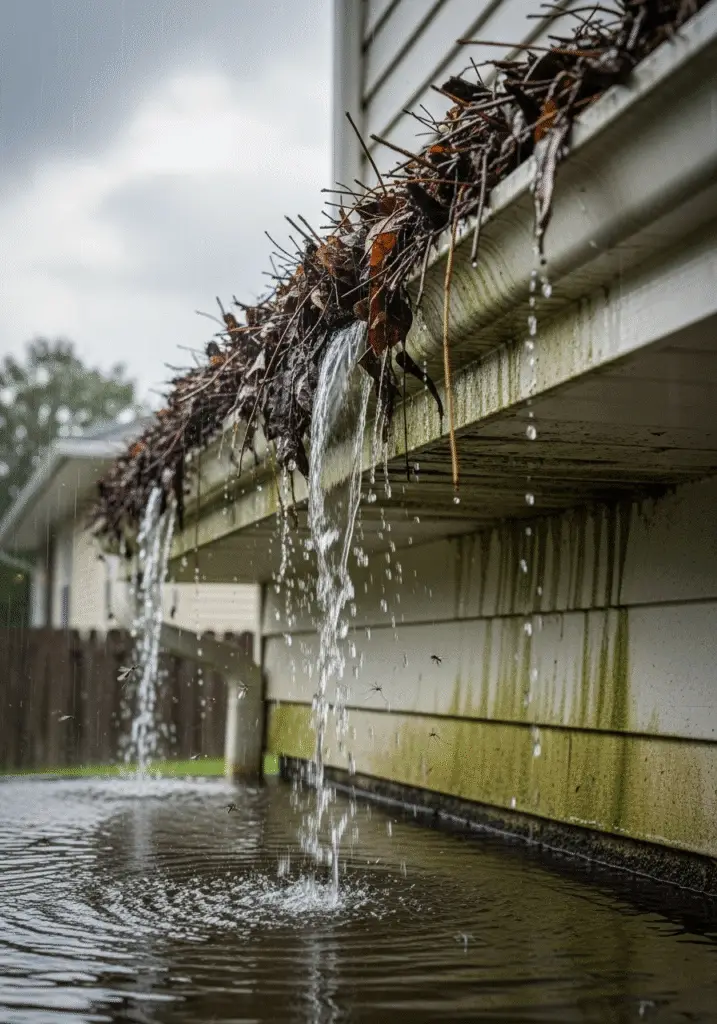
Signs Your Gutters Need Cleaning
While gutter cleaning is a seasonal task, many homeowners often delay it until problems become visible—by which time the damage may already be underway. Regular inspection of your gutter system is crucial to prevent water damage, pest issues, and structural problems. So how can you tell when your gutters are in need of immediate attention? Here are some common warning signs that it’s time to clean them out—preferably before the rainy season starts.
1. Water Spilling Over the Edges During Rainfall:
This is one of the most obvious signs. When water isn’t flowing freely through the gutters and downspouts, it backs up and spills over the sides. Overflowing gutters can damage your siding, erode your landscaping, and allow water to pool around your home’s foundation.
2. Sagging or Detached Gutters:
Clogs can cause water and debris to become so heavy that your gutters begin to sag or even pull away from the roofline. This compromises their structure and function, leading to uneven water flow and potential roof damage. A sagging gutter is more than just an eyesore—it’s a signal that immediate maintenance is required.
3. Plant Growth, Moss, or Weeds in the Gutters:
Your gutters aren’t supposed to be miniature gardens. If you notice small plants, moss, or weeds growing out of them, it’s a clear sign that dirt and debris have built up over time. Organic matter trapped in the gutters creates fertile ground for unwanted vegetation, which only worsens blockages.
4. Stains or Streaks on Your Exterior Walls:
Discoloration or dirty streaks on your siding may result from water continuously running down the outside of your house instead of being properly channeled away. These stains are not only unattractive but also indicative of poor gutter performance due to clogs.
5. Pests Nesting in the Gutters:
Insects, birds, and even rodents are attracted to clogged gutters filled with leaves and stagnant water. If you spot bird nests, hear scurrying sounds, or see mosquitoes hovering around your gutters, it means they’ve become a haven for pests. This can eventually lead to infestations inside your home.
6. Water Pooling Around the Foundation:
One of the most serious signs is standing water around your home’s base. When gutters are blocked and water can’t be directed away, it seeps into the soil surrounding your foundation. Over time, this can lead to cracks, leaks, and even flooding in the basement.
Don’t Wait for the Damage to Escalate:
If you notice even one of these signs, it’s time to take action. Cleaning your gutters before the first big rainstorm can prevent thousands of rupees—or dollars—in home repairs. Staying ahead of these issues ensures that your home remains protected, structurally sound, and pest-free during the rainy season and beyond.
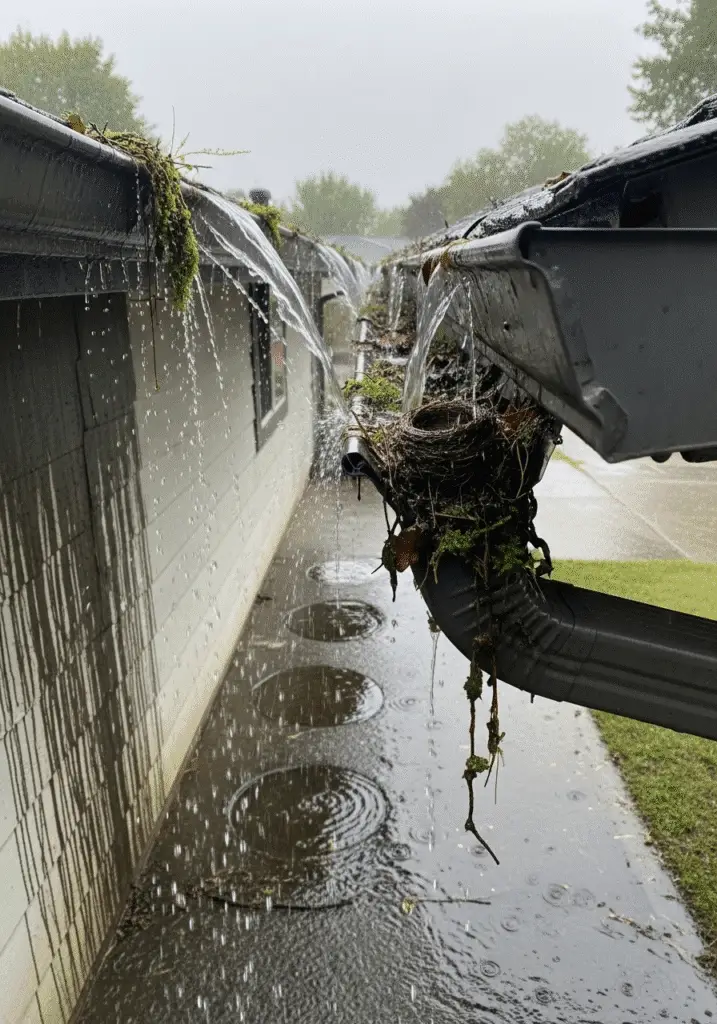
Tools You’ll Need for Gutter Cleaning
Before you begin any type of home maintenance, preparation is key—and gutter cleaning is no exception. Having the right tools on hand not only makes the job more efficient but also helps keep you safe while working at heights. Cleaning gutters involves removing debris, flushing the system, and inspecting for signs of wear or damage. Below is a breakdown of the essential tools every homeowner should have before starting the job, along with a few expert tips to make the process smoother.
1. Sturdy Ladder (with Stabilizers Recommended):
A reliable ladder is arguably the most important tool you’ll use. Opt for a sturdy extension or step ladder that can safely support your weight and reach your gutters without overextending. For added safety, consider using a ladder stabilizer or stand-off arm, which helps keep the ladder from damaging your gutters and provides a more secure grip against the wall. Always place the ladder on flat, level ground, and avoid working in windy or slippery conditions.
2. Heavy-Duty Gloves:
Gutter debris often includes sharp twigs, nails, wet leaves, and even insect nests. Protect your hands with durable, water-resistant gloves made of thick rubber or leather. Gloves also help you maintain a better grip when handling tools or scooping out debris.
3. Gutter Scoop or Trowel:
While it’s possible to clean gutters with your hands, a gutter scoop or garden trowel speeds up the process and helps you dig out compacted muck more efficiently. Plastic scoops are ideal because they’re less likely to scratch or damage your gutters.
4. Bucket or Trash Bag:
To keep your workspace clean, bring along a bucket or attach a trash bag to your ladder to collect debris as you work. This minimizes the mess around your yard and makes cleanup quicker once you’re done.
5. Garden Hose with Spray Nozzle:
After removing the bulk of the debris, use a garden hose to flush out any remaining dirt and check for proper water flow. A high-pressure spray nozzle works best to force out stubborn residue and test for leaks or blockages in downspouts.
6. Safety Goggles:
As you flush out the gutters or scoop debris, particles can fly up unexpectedly. Wearing protective eyewear shields your eyes from dust, mold spores, and sharp debris that could otherwise cause injury.
7. Gutter Cleaning Wand (Optional):
For multi-story homes or areas that are difficult to reach with a ladder, a telescoping gutter cleaning wand can be a lifesaver. These wands connect to your garden hose and allow you to spray inside the gutter from the ground, offering a safer, no-ladder option for lighter cleaning jobs.
Pro Safety Tip:
Never climb onto the roof to clean your gutters unless you have proper safety gear and roofing experience. If you’re unsure or your home is taller than one story, it’s best to have someone nearby to spot the ladder or hire a professional service.
By using the right tools and following safety protocols, you can clean your gutters efficiently and reduce the risk of injury. Proper preparation ensures a thorough job and keeps your drainage system functioning smoothly throughout the rainy season.
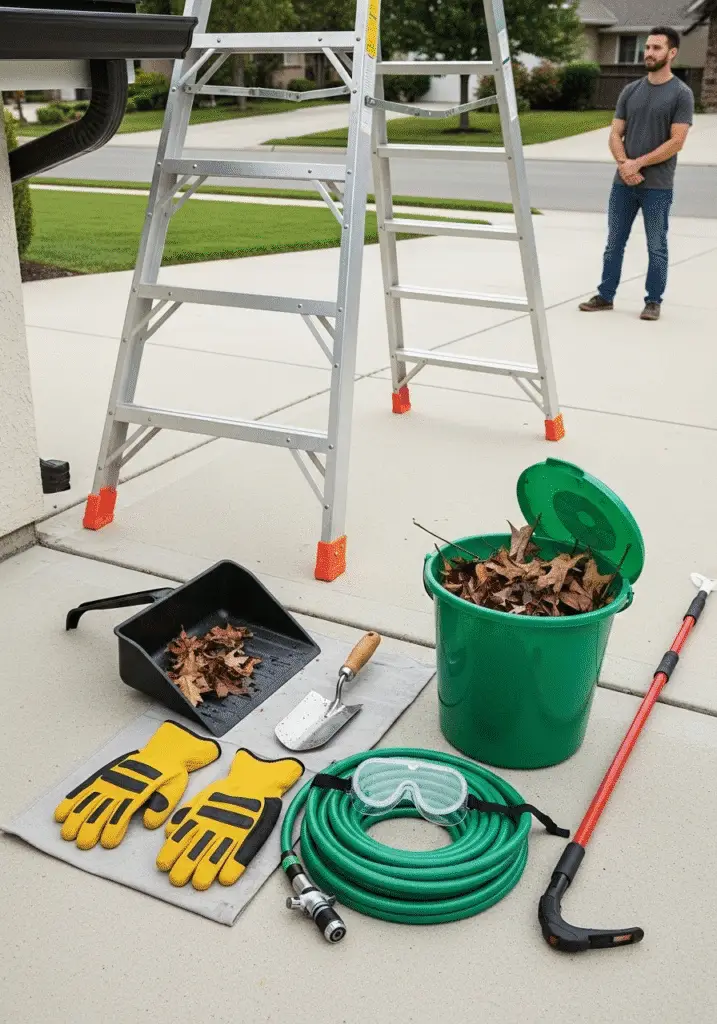
Step-by-Step Guide to Cleaning Gutters Safely
Cleaning your gutters may not be the most glamorous chore, but it’s one of the most essential when preparing for the rainy season. A well-maintained gutter system ensures proper water drainage and protects your home from leaks, foundation issues, and mold. To make the task simple and risk-free, follow this step-by-step guide to clean your gutters thoroughly and safely.
Step 1: Position Your Ladder Securely
Safety begins before the cleaning even starts. Choose a sturdy, reliable ladder and place it on level, firm ground. If available, use ladder stabilizers or stand-off arms to prevent direct pressure on the gutters and to create a more stable climbing position. Always ensure the ladder extends three feet above the roofline if you’re climbing to a second story. Never lean too far to one side—climb down and reposition the ladder instead. If possible, have someone nearby to hold the ladder and assist.
Step 2: Scoop Out Debris
Starting at the end closest to the downspout, use a gutter scoop, garden trowel, or even gloved hands to remove built-up debris. This includes leaves, twigs, seed pods, dirt, and sludge. Place the debris in a bucket hooked onto the ladder or use a trash bag for easy cleanup. Work your way along the gutter system in small sections to prevent buildup from falling back into cleaned areas.
Step 3: Flush With Water
Once the debris is cleared, use a garden hose with a spray nozzle to flush the gutters. Begin at the end farthest from the downspout and work your way toward it. This helps push any leftover sediment down and tests the gutter’s drainage efficiency. Watch for proper water flow. If the water flows smoothly out of the downspouts, you’re in good shape.
Step 4: Check the Downspouts
If water backs up or trickles out slowly, your downspout is likely clogged. Use a plumber’s snake or a high-pressure garden hose attachment to clear out blockages. Insert the tool from both the bottom and the top if necessary, and be patient—it may take a few tries. In some cases, you may need to detach the downspout elbow to manually clear a stubborn clog.
Step 5: Inspect for Damage
With the gutter system now clean, it’s the perfect time to inspect for any signs of wear and tear. Look for rust spots, cracks, holes, or sagging sections. Check that all hangers and brackets are secure and that gutters have the proper slope for drainage. Tighten loose fasteners, seal small cracks with gutter caulk, and replace any broken parts before the next rainstorm hits.
Bonus Tip:
Take a photo of any problem areas you can’t fix immediately. This will help you remember what needs professional attention or future maintenance.
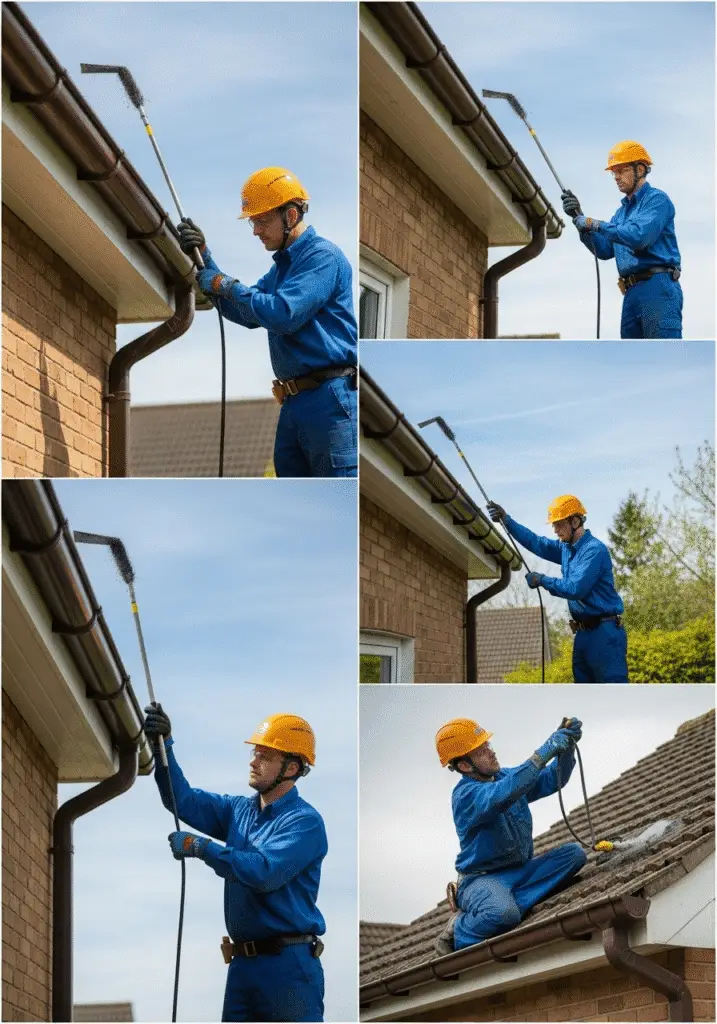
How to Check for Damage or Clogs
Once your gutters are clean and clear of debris, the next critical step is inspection. Gutter systems are exposed to the elements year-round, and over time, they can develop damage that isn’t always obvious at first glance. Regular inspection—especially after cleaning—is essential to ensure that your gutters function efficiently and won’t fail you during the rainy season.
Here’s a detailed guide on what to look for and how to catch small issues before they turn into expensive problems.
1. Leaks and Dripping Seams
Turn on your garden hose and run water through the gutter system. While water flows, carefully observe the seams and joints. If you notice water dripping from the connections or from small pinholes along the gutter walls, you’re dealing with leaks. These leaks can often be sealed using a high-quality gutter sealant or caulking. However, larger gaps or rusted-out sections may require replacing a portion of the gutter entirely.
2. Loose Fasteners or Hanging Sections
Over time, the weight of debris and water—or even thermal expansion and contraction—can cause fasteners like nails, screws, or gutter hangers to loosen. This may result in sagging or partial detachment of the gutter from the fascia board. Check all fasteners and brackets. If nails have pulled loose, replace them with gutter screws, which provide a stronger and longer-lasting hold. Ensure that each section is firmly secured and properly aligned.
3. Improper Slope or Pitch Issues
Gutters are designed to work with gravity, so they must have a slight slope toward the downspout—typically about 1/4 inch for every 10 feet of gutter. Use a level to check the slope. If water pools or remains standing in one section of the gutter after flushing, that’s a sign the pitch is off. Reposition the hangers or install new ones at the correct height to restore proper drainage. Incorrect slope can cause water to overflow during heavy rains or freeze during colder months, leading to cracks or ice dams.
4. Clogs in Underground or Extended Drains
If your downspouts are connected to underground drainage systems, don’t assume they’re clear just because the above-ground gutter looks clean. Pour water into the downspout and watch where it exits. If water backs up or comes out slowly, the underground drain may be clogged with roots, dirt, or compacted debris. Use a plumber’s snake, drain auger, or high-pressure nozzle to break up the blockage. In severe cases, you may need professional drain cleaning services to restore full function.
5. Rust, Corrosion, or Structural Deterioration
For metal gutters, inspect for rust spots, peeling paint, or corrosion—especially at seams or corners. Left untreated, these issues can weaken the structure of the gutter and lead to eventual collapse. Apply a rust inhibitor or sealant to affected areas, and repaint if necessary to prevent further weather damage.
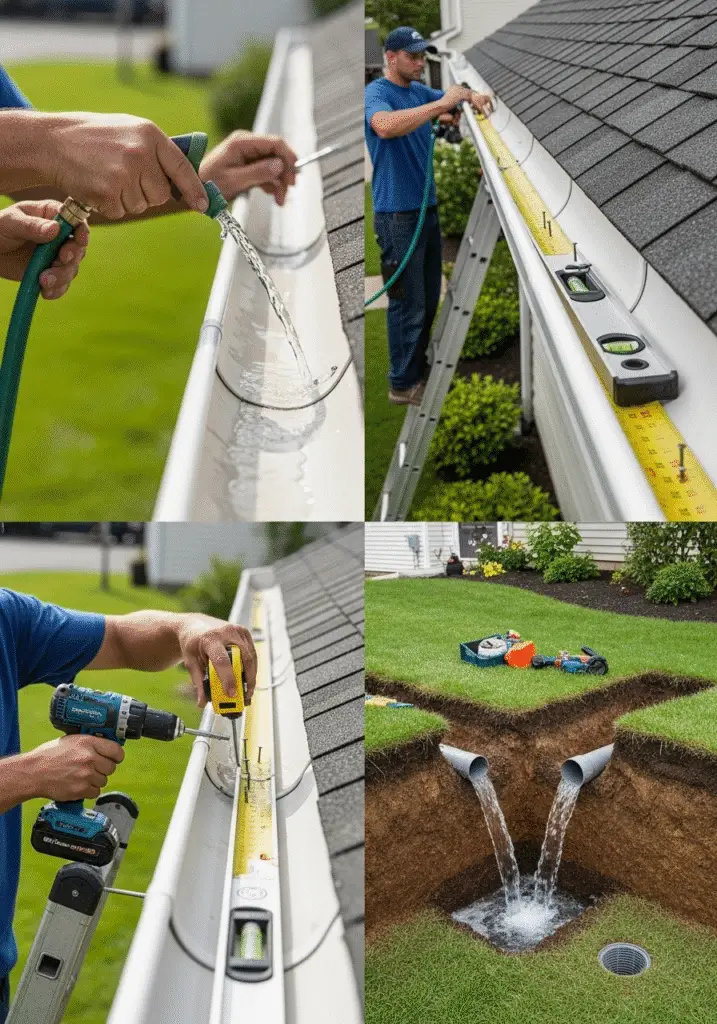
Preventive Maintenance Tips
Gutter cleaning isn’t a one-time job to check off your to-do list—it’s an ongoing part of responsible homeownership. Even if you’ve just completed a thorough cleaning, your gutters will continue to collect debris, especially during the fall season or after a storm. Without regular maintenance, even the cleanest gutter systems can quickly become clogged or damaged, leading to costly repairs down the road. The key to long-lasting, efficient gutters is simple: stay proactive, not reactive.
Here are several preventive maintenance tips to help you keep your gutters in top shape year-round:
1. Clean Gutters at Least Twice a Year
At minimum, schedule a deep cleaning for your gutters in both spring and fall. Spring cleaning helps remove seeds, pollen, and leftover winter debris. Fall cleaning clears out the heavy leaf drop that can quickly clog the system. If your home is surrounded by trees, you may need to clean more frequently.
2. Trim Overhanging Branches
Trees are a major source of gutter clogs. Leaves, twigs, sap, and even acorns or seed pods can quickly fill your gutters. By trimming back overhanging branches near your roofline, you significantly reduce the amount of organic matter falling into the gutters. This also helps discourage birds, squirrels, and other pests from nesting in the system.
3. Check for Debris After Storms or High Winds
Heavy storms, especially those with strong winds or hail, can deposit a surprising amount of debris into your gutters. After any major weather event, take a few minutes to inspect your system. Remove large items by hand and check that the downspouts are still clear.
4. Run Water Through the System Monthly During Rainy Months
During rainy seasons, make it a habit to test your gutter flow by running water through the system once a month. This not only flushes out minor debris buildup but also helps you spot potential clogs or leaks early—before they become major problems. A quick hose test can save you from discovering an overflow during a real downpour.
5. Paint or Seal Rusty Areas
Rust is a common problem in older metal gutters. Once rust sets in, it can weaken the gutter material, leading to leaks or full sections detaching from the home. To prevent corrosion, inspect the gutters for any signs of surface rust or worn paint. Use a wire brush to remove rust, apply a metal primer, and repaint or seal the area with a rust-inhibiting product. This small maintenance task can extend the life of your gutter system by years.
6. Install Gutter Guards for Extra Protection
While optional, gutter guards can dramatically reduce the amount of debris that enters your system. These mesh or screen covers sit on top of your gutters and allow water to pass through while blocking leaves, twigs, and other debris. Though they don’t eliminate the need for maintenance entirely, they can significantly reduce cleaning frequency.
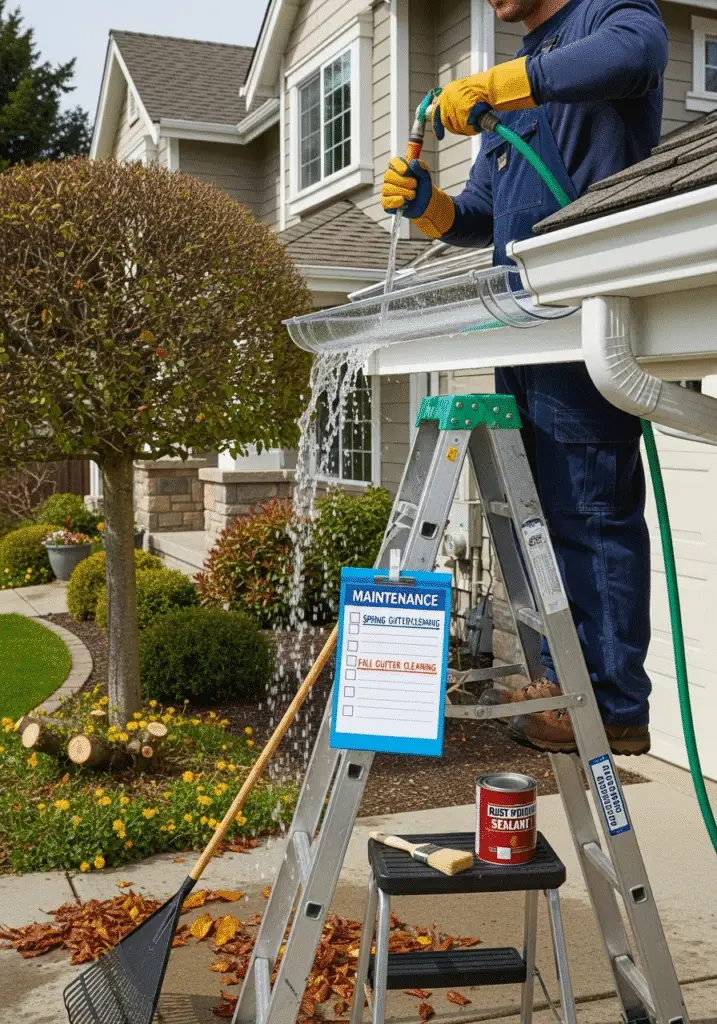
Gutter Guards: Are They Worth It?
If you’re tired of cleaning your gutters multiple times a year or dealing with frequent clogs and water overflow, you may have considered installing gutter guards. These systems are designed to reduce the amount of debris that enters your gutters, making maintenance easier and more manageable over time. But are they really worth the investment?
Let’s explore what gutter guards are, how they work, and the pros and cons to help you decide if they’re the right solution for your home.
What Are Gutter Guards?
Gutter guards are protective barriers—usually made from metal, plastic, or foam—that sit on top of or inside your existing gutter system. Their purpose is to block leaves, twigs, and other debris from entering while still allowing rainwater to flow freely through the gutter and into the downspout. There are several types available, each with its own benefits and price points:
- Mesh Screens: Fine wire or plastic screens that cover the gutter and block small debris.
- Foam Inserts: Porous foam pieces that fit directly inside the gutter, allowing water through but blocking larger debris.
- Reverse-Curve Systems: Curved covers that guide water into the gutter while forcing debris to slide off the edge.
Benefits of Gutter Guards (Pros):
Reduce Cleaning Frequency:
Gutter guards dramatically reduce the number of times you’ll need to clean your gutters throughout the year. This can save you time and labor—especially if you normally hire professionals for the job.
Minimize Clogs and Overflows:
By keeping out leaves, pine needles, and twigs, gutter guards help prevent the blockages that lead to water overflow, foundation pooling, and roof leaks during the rainy season.
Deter Pests and Nesting:
Open gutters often attract birds, squirrels, insects, and other pests looking to nest. Gutter guards create a barrier that deters them from entering and turning your drainage system into a home.
Improve Water Flow Efficiency:
Clean, clog-free gutters are more efficient at channeling water away from your home, helping to reduce the risk of soil erosion, basement flooding, and siding damage.
Drawbacks of Gutter Guards (Cons):
Not Completely Maintenance-Free:
While they reduce the amount of debris entering the gutter, they don’t eliminate maintenance entirely. Some small particles like pollen, dirt, or shingle grit can still build up and require occasional flushing or brushing.
Initial Installation Costs:
Depending on the type and brand, gutter guard systems can range from a few hundred to several thousand rupees (or dollars) for professional installation. DIY options are available but may not be as durable or effective.
Fit and Compatibility Issues:
Not all gutter guards are universal. Some may not fit older gutters, or homes with complex rooflines and heavy rainfall may need specialized products to handle water volume.
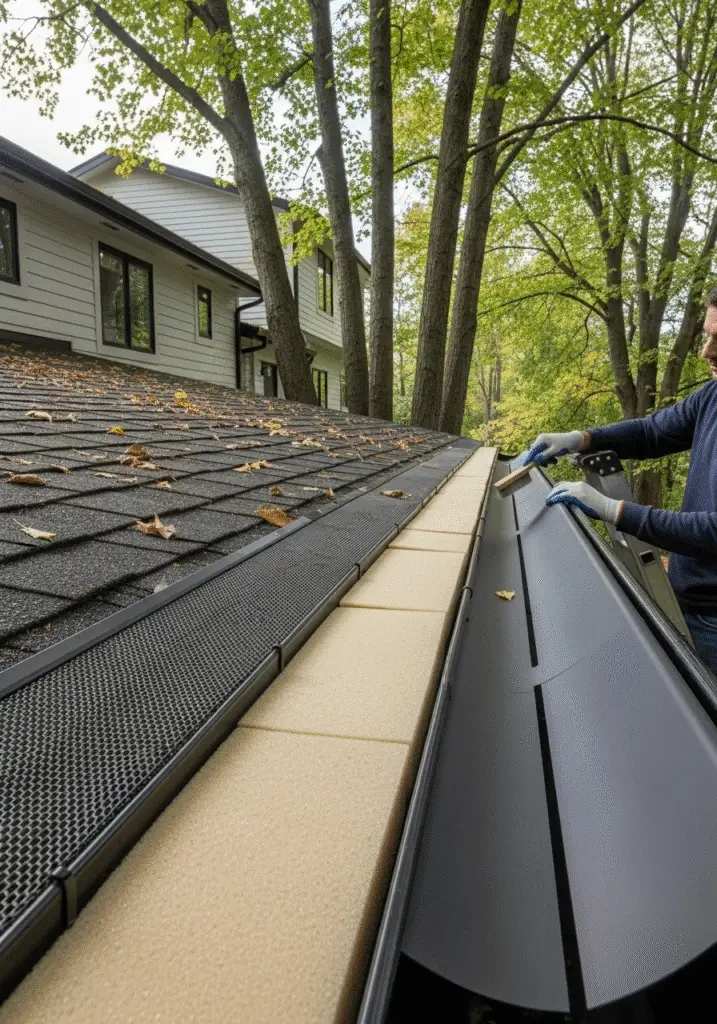
DIY vs Hiring Professionals
When it comes to gutter cleaning, many homeowners wonder whether they should take the do-it-yourself (DIY) route or call in the professionals. The answer isn’t always straightforward—it largely depends on your home’s design, your physical comfort with heights, and your budget. Both options come with their own advantages and limitations. Understanding them can help you make the right choice for your safety, wallet, and home’s long-term health.
DIY Gutter Cleaning
Pros:
More Budget-Friendly
Cleaning your gutters yourself is undoubtedly cheaper. With basic tools like a sturdy ladder, gloves, and a hose, you can take care of most clogs and buildup without spending money on labor costs.
Ideal for Single-Story Homes
If you live in a single-story home or a house with a low-pitched roof, DIY cleaning can be manageable and relatively safe—especially with the right precautions and tools.
Cons:
Time-Consuming and Physically Demanding
Gutter cleaning is not a quick job. It requires patience, effort, and the ability to safely maneuver on a ladder. You’ll also need to dispose of debris, flush the system, and inspect for damage.
Safety Risks
Working at heights always comes with risks. Falls from ladders are one of the most common causes of household injuries. If you’re uncomfortable with heights or have limited mobility, it’s best not to take the risk.
Professional Gutter Cleaning
Pros:
Thorough and Safe Service
Hiring a licensed gutter cleaning professional means your system will be cleaned safely and effectively—especially in hard-to-reach areas or on multi-story homes. Professionals are trained, insured, and equipped with specialized tools.
Ideal for Complex Rooflines or Tall Homes
Homes with steep, high, or multi-tiered roofs can be dangerous to access without experience. Professionals can handle these challenges quickly and efficiently.
Added Value: Inspection and Minor Repairs
Most reputable gutter cleaning services don’t just remove debris—they also check for potential problems. They can identify leaks, sagging sections, or early signs of damage and may perform minor fixes on the spot, saving you from future repair bills.
Cons:
Higher Upfront Cost
Professional services cost more than doing it yourself, but the price includes labor, equipment, insurance coverage, and expertise. For many homeowners, the peace of mind is worth the investment.
Which Option Is Right for You?
If you’re confident working on a ladder and your home is a single story, DIY may be a good option to save money—especially if you already have the tools. However, if your home is large, surrounded by trees, has complex gutters, or you simply prefer not to risk your safety, hiring professionals is the smarter and safer choice.
Tip: If you’re unsure which route to take, get a free estimate from a local, licensed gutter cleaning service. You can compare the cost of hiring help with the time and effort required to do it yourself—and make the decision that best fits your needs and comfort level.
